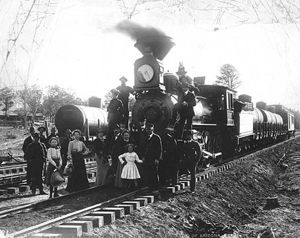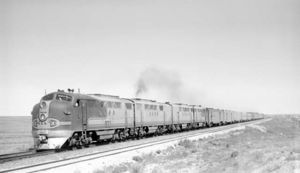Grand Canyon Limited: Difference between revisions
imported>Robert A. Estremo mNo edit summary |
imported>Robert A. Estremo mNo edit summary |
||
| Line 1: | Line 1: | ||
{{subpages}} | {{subpages}} | ||
[[Image:ATSF Grand Canyon Limited at Belen.jpg|thumb| | [[Image:ATSF Grand Canyon Limited at Belen.jpg|thumb|400px|right|{{ATSF Grand Canyon Limited at Belen.jpg/credit}}<br />The ''Grand Canyon Limited'', led by [[Atchison, Topeka and Santa Fe Railway|Santa Fe]] No. 5021, departs Belen, New Mexico under a full head of steam on January 12, 1947.]] | ||
[[Image:ATSF Grand Canyon Limited combined.png|thumb|200px|right|{{ATSF Grand Canyon Limited combined.png/credit}}<br />"[[Drumhead (sign)|Drumhead]]" logos such as these often adorned the ends of observation cars on the ''Grand Canyon Limited''.]] | [[Image:ATSF Grand Canyon Limited combined.png|thumb|200px|right|{{ATSF Grand Canyon Limited combined.png/credit}}<br />"[[Drumhead (sign)|Drumhead]]" logos such as these often adorned the ends of observation cars on the ''Grand Canyon Limited''.]] | ||
[[Image:Grand Canyon Railway 1901.jpg|thumb|300px|right|{{Grand Canyon Railway 1901.jpg/credit}}<br />A group of passengers pose for a photograph just before the inaugural run of the Grand Canyon Railway in 1901.]] | [[Image:Grand Canyon Railway 1901.jpg|thumb|300px|right|{{Grand Canyon Railway 1901.jpg/credit}}<br />A group of passengers pose for a photograph just before the inaugural run of the Grand Canyon Railway in 1901.]] | ||
The '''''Grand Canyon Limited''''' was one of the | The '''''Grand Canyon Limited''''' was one of the [[Named passenger trains of the Atchison, Topeka and Santa Fe Railway|named passenger trains of the Atchison, Topeka and Santa Fe Railway]] (AT&SF). It was assigned train Nos. 23 & 24, and its route stretched between [[Chicago, Illinois]] and [[Los Angeles, California]]. In 1901, the Santa Fe Railroad completed a 64-mile (103-kilometer) long branch line from Williams, [[Arizona]] to "Grand Canyon Village" at the South Rim of [[Grand Canyon National Park]]. The first scheduled train of the '''''Grand Canyon Railway''''' to convey paying passengers arrived from Williams on September 17 of that year. Branch line trains as well as special excursions departing from Southern California, Chicago, and [[Texas]] (and travelling directly to the canyon rim) were often schedule as a part of the Santa Fe's Southwestern promotional strategy. Finally, on June 29, 1929, service commenced on the ''Grand Canyon Limited'', named for the railroad's most popular tourist attraction. It quickly became one of America's most celebrated vacation trains. Under typical operation the westward trains were split in two sections upon arrival at Barstow, in order that one section could travel directly to [[San Francisco]] ([[Oakland, California|Oakland]]-Richmond) via the Tehachapi Loop, while the other continued on to Los Angeles. During [[World War II]], the ''Limited'' was often run in two or three sections to transport troops between Chicago-Los Angeles and San Francisco. In its later years, the train steadily lost passengers to the railroad's flashier, more-modern name trains such as the ''[[Super Chief]]'' and its streamlined passenger cars. | ||
The last train of the ''Grand Canyon'' completed its run on January 8, 1970, its equipment having been transferred to the Santa Fe's ''San Francisco Chief''. | The last train of the ''Grand Canyon'' completed its run on January 8, 1970, its equipment having been transferred to the Santa Fe's ''San Francisco Chief''. | ||
Revision as of 21:33, 30 September 2014

The Grand Canyon Limited, led by Santa Fe No. 5021, departs Belen, New Mexico under a full head of steam on January 12, 1947.

"Drumhead" logos such as these often adorned the ends of observation cars on the Grand Canyon Limited.
The Grand Canyon Limited was one of the named passenger trains of the Atchison, Topeka and Santa Fe Railway (AT&SF). It was assigned train Nos. 23 & 24, and its route stretched between Chicago, Illinois and Los Angeles, California. In 1901, the Santa Fe Railroad completed a 64-mile (103-kilometer) long branch line from Williams, Arizona to "Grand Canyon Village" at the South Rim of Grand Canyon National Park. The first scheduled train of the Grand Canyon Railway to convey paying passengers arrived from Williams on September 17 of that year. Branch line trains as well as special excursions departing from Southern California, Chicago, and Texas (and travelling directly to the canyon rim) were often schedule as a part of the Santa Fe's Southwestern promotional strategy. Finally, on June 29, 1929, service commenced on the Grand Canyon Limited, named for the railroad's most popular tourist attraction. It quickly became one of America's most celebrated vacation trains. Under typical operation the westward trains were split in two sections upon arrival at Barstow, in order that one section could travel directly to San Francisco (Oakland-Richmond) via the Tehachapi Loop, while the other continued on to Los Angeles. During World War II, the Limited was often run in two or three sections to transport troops between Chicago-Los Angeles and San Francisco. In its later years, the train steadily lost passengers to the railroad's flashier, more-modern name trains such as the Super Chief and its streamlined passenger cars.
The last train of the Grand Canyon completed its run on January 8, 1970, its equipment having been transferred to the Santa Fe's San Francisco Chief.
History
Timeline
- September 17, 1901: The Santa Fe inaugurates service on the Grand Canyon Railway, running between Williams, Arizona and the South Rim of Grand Canyon.
- January 1905: The first-class, Santa Fe-built El Tovar Hotel opens its doors. The structure is situated just 20 feet from the canyon rim.
- June 29, 1929: The Grand Canyon Limited enters service with an "over-the-road" schedule of 58 hours.
- June 4]], 1938: Both the Grand Canyon Limited and the Navajo are rerouted over the Belen cutoff through Amarillo, Texas. Transit time is reduced to 55 hours.
- July 7, 1945: Combined train No. 2 (the Scout) and No. 24, powered by locomotive #3733, strikes a "Caterpillar" shovel. The locomotive's pilot, headlight, and cylinders are damaged in the collision.
- June 2, 1946: The Grand Canyon Limited is rerouted from Santa Fe's Second District (via Pasadena) to the Third District (via Riverside-Fullerton) to balance the number of passenger trains entering the Los Angeles Union Passenger Terminal (LAUPT).
- June 8, 1947: The line receives its first diesel locomotives and stainless-steel lightweight passenger cars. The train is broken into two separate sections and the name is shortened to the Grand Canyon. The operating schedule is reduced to 48 hours, 45 minutes.
- December 27, 1949: Train No. 23 collides with an automobile at a grade crossing in Highland Park, California, which flattens the wheels on the locomotives.
- May 31, 1951: Combined train No. 2 (the Scout) and No. 23 is sideswiped by train No. 123 in Chandler, Arizona, derailing cars #RSX 287, express #2558, baggage #1634, and "chair" cars #3108 and #3070. No. 123 cars baggage #1791 and #1601, "chair" cars #3087, #3158, and #1169, diner #1461, lounge #136, and sleepers L.S. Hungerford, Tonelea, Toreva, and Centgate also sustain damage.
- April 5, 1964: Train No. 123, consisting of five locomotives and 16 cars, encounters a rockslide while traveling at 81 miles-per-hour through Doublea, Arizona.
- January 7, 1970: Service on the northern section (via the Raton Pass) of the Grand Canyon is discontinued; service is shunted to the San Francisco Chief.
- January 8, 1970: The southern section (via Belen, New Mexico) of the Grand Canyon is withdrawn from service due to a steady decline in ridership.
Equipment
A wide variety of steam- and diesel-powered locomotives served the Grand Canyon Limited over the course of its lifetime.
The original rolling stock delivered for the second-class Grand Canyon Limited consisted of all heavyweight cars built by the Pullman-Standard. The equipment used on both trains was as follows:
- a Baggage-Dormitory-Buffet Smoking Car
- two "Chair" cars (Coaches)
- a Dining car
- three compartment and drawing-room Sleepers
- a full open-end Observation / Parlor car
Train consists varied daily as traffic density fluctuated; the train often ran in two or three sections during the summer months.
Near the end of its career, in 1968, reflecting the dwindling passenger traffic of the time, a typical consist between the Chicago and Kansas City portion of the trip was as follows:
- Two Alco PAs
- One Streamline Baggage Car
- Two coaches

